Introduction to the Universe
390-401
There is something fascinating about science. One gets such a wholesale return of conjecture out of such a trifling investment of fact
Mark Twain, Life on the Mississippi ,1883
Does the universe have an edge or a centre? Why is it dark at night? Odd questions but ones that get to the heart of the matter when considering the structure and history of our universe. You will encounter these questions and others in this section.
The Edge-Centre Problem
The universe has no edge. It is infinite in extent, although what this means also depends on the geometric structure of space which will be discussed in the next section. Similarly, since the universe has no edge neither can it have a centre. On first consideration this may seem strange. Your house or city has both an edge and centre. But the universe cannot be like this. If you came to the edge of the universe what would lie beyond it? It is impossible to reach an edge.
Example 15.1 Why would it be reasonable for Newton and his contemporaries to suggest that a static universe of stars must be infinite in order to be stable from collapse?
Solution:Newton's Law of Universal Gravitation would imply that all stars would attract each other - the universe should collapse unless each star felt the same force in all directions. This is really says then that there can be no preferred location or centre in the universe and the universe must be infinite. Why? An edge would be inconsistent with the idea of no "preferred" or distinct location. A star at the "edge" could not be pulled equally in all directions.
Why is the Sky Dark at Night - Olbers' "Paradox"
This seems like an odd question. Yet, when you ponder it an unsettling problem begins to emerge. Clearly - without the Sun it should be dark .... but what about the stars? If the universe contained an infinite number of stars then no matter what direction you looked you should be looking in the direction of a star.
Even if some stars are far away their light will eventually reach you. You would then expect that the night sky should be about as bright as the surface of a star. You can help visualize this with the applet olber provided in Figure 15.1. This captures the essence of Olbers' paradox. Possible Resolutions of Olbers' Paradox
|
|
| Figure 15.1 |
- The universe may be expanding. OK: this could work. Eventually stars and galaxies are moving away so fast that the light will never reach us in visible form (it will be redshifted). The universe will be infinitely old in this scenario and hence also infinitely big.
- The universe is finite in age and there was an epoch of star formation. OK: this seems to be the current wisdom on the problem. As we look deeper into space we eventually look back to an epoch pre-dating the formation of stars and galaxies. (Deep Trivia... Edgar Allan Poe (circa 1848) was one of the first to suggest that this as the resolution of Olbers' Paradox!)
Cosmic Expansion, the Big Bang and the Age of the Universe
In 1929 Edwin Hubble and Milton Humanson published research indicating that the universe was expanding. This profound discovery ranks as one of the greatest scientific discoveries of the last century. With the clarity of hindsight one could argue that Olbers' Paradox anticipates this but that is far too simplistic. Even Einstein himself "fudged" his equations for gravity to prevent an expanding universe. At the time he created his Theory of General Relativity (about 1915) there was no evidence for cosmic expansion and Einstein felt it was only "sensible" that the universe should be static. When he learned of Hubble and Humanson's discovery he realized that his fudging of the equations was the greatest scientific blunder of his life. We will return to Einstein's theory of gravity in the next section.
The Hubble Expansion Law (![]() ) is really describing the rate of expansion of space (the universe) itself. No matter what point you are are at in the universe you would see galaxies - in all directions moving away from you in a manner described by this law. Thus - there is no centre to the universe - every point appears to be the centre!
) is really describing the rate of expansion of space (the universe) itself. No matter what point you are are at in the universe you would see galaxies - in all directions moving away from you in a manner described by this law. Thus - there is no centre to the universe - every point appears to be the centre!
If the universe is expanding then this suggests a beginning and the modern resolution of Olbers' paradox requires this as well. The origin event is called the Big Bang. The name is unfortunate (and was given by the British astronomer Sir Fred Hoyle in the early 1960's). The name suggests an "explosion" with galaxy bits flying in all directions. It is not that! The origin point or Big Bang was the creation of space and time itself. Galaxies are moving apart because the space between them is expanding.
 |
Figure 15.2 depicts our observable universe. The observable universe is determined by the rate of expansion of the universe and the time since the Big Bang ("Age of the Universe"). It is important to distinguish between the universe and the observable universe. The observable universe is that part of the universe we can interact with - it has a definite beginning point and a finite size. We can estimate the age of the observable universe by making a very simple argument: Hubble's expansion law is: "distance" = speed X time or
|
| Figure 15.2 Depiction of the observable universe - we can look-back to an era roughly 300 000 years after the Big Bang. |
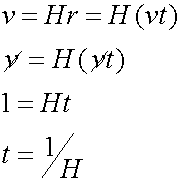
Thus - the age of the observable universe is inversely related to the size of Hubble's constant! This is also called the Hubble Age since it is derived from Hubble's constant. In the next section we will look at more sophisticated ways to estimate the age of the universe.
Example 15.2 Estimate the age of the observable universe given H = 71 km/s/Mpc
Solution: First, notice that the unit "km/s/Mpc" is made up of distance (km)and 1/time (1/s) divided by distance (Mpc). This is equivalent to units of 1/time. Convert Mpc to km:
1 Mpc = (1 million)X(3.08 X 1013 km ) = 3.08 X 1019 km so H = 71 km/s/(3.08 X 1019 km) = 2.3 X 10-18 1/s. If this is used in t = 1/H you get:
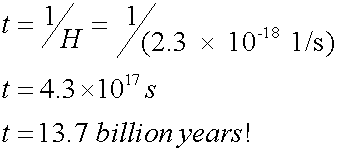
Example 15.2 implies that roughly 13.7 billion years ago the observable universe was confined to a tiny volume (smaller than a walnut!). This is a bizarre and intriguing thought but one for which there is strong evidence!
The Primeval Fireball
In the mid 1960's two Bell Laboratory scientists, Arno Penzias and Robert Wilson were attempting to "work the bugs" out of a very sensitive microwave antenna. Despite their best efforts, an annoying "hiss" persisted. After many attempts and modifications they reached a startling conclusion. There was nothing wrong with the antenna. They were detecting a background signal created by the universe itself! This was the discovery of the "primeval fireball" or cosmic microwave background radiation. In fact - this very thing had been predicted in 1948 by the physicist George Gamow who speculated about the early conditions of the Big Bang. Gamow reasoned that the early universe would be in a very dense and extremely hot state
. As you learned earlier this would mean that the universe would be expected to radiate like a black body. Just as the embers in a camp fire glow and remain warm for many hours after the fire has gone out, so should the tremendous heat if the early universe glow. Cosmic expansion would redshift the glowing radiation into the microwave region. This is just what Penzias and Wilson found. Figure 15.3 shows a black body curve constructed by measuring the microwave background radiation. This is consider one of the key pieces of evidence for the Big Bang. After 13.7 billion years, the microwave background radiation has been redshifted by an enormous amount. Figure 15.3 indicates that it is equivalent to the black body radiation produced by an object at a temperature of 2.73 K. |
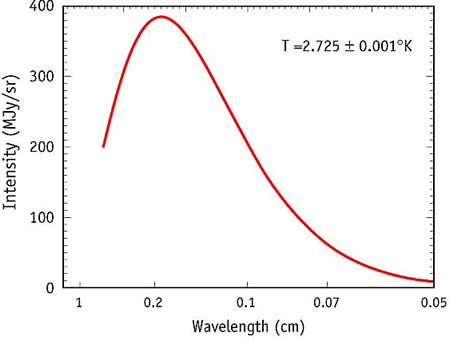 |
| Figure 15.3 The blackbody spectrum of the Cosmic Microwave Background |
Example 15.3 Use Wien's Law to estimate the wavelength of radiation produced by the "glow" left over from the Big Bang.
Solution: Wien's Law relates temperature and wavelength of maximum intensity emission for a black body. It can be written as 
The universe appears to be bathed in microwave radiation of wavelength 1.06 mm.
Describing the Big Bang
The Very Early Universe - The Radiation Era
The early universe - up to an age of about 1000 years was dominated by radiation and hence is called the radiation era. The universe in the Big Bang starts as a dense "nut" that suddenly expands, producing space and time. The universe begins at an enormous temperature. Matter as we know it would not exist at these temperatures. Physicists expect that in the early universe - only a few billionths to a few 10's of seconds old - would be made up of strange, exotic particles continually colliding and transmuting into other particles. After 10 s or so the universe would have cooled enough to produce he "normal" nuclear matter that we are familiar with. Now comes a critical time in the universe - the formation of elements.Accounting to the Hot - Big Bang all the original elements of the cosmos would be made in the next 35 minutes! The Big Bang model is able to explain very well the abundance ratios of the Hydrogen, Helium and their isotopes.
The Problem of the Heavy Elements
According to the Big Bang the elements formed as follows:- H ---->> He
- He --->> Li STOP, END, FINISH!
The Matter Era
For the first few thousands of years after the Big Bang the universe was still too hot for ordinary atoms to exist. After about 380 000 years the universe had cooled to about 3000 K and hydrogen atoms were able to form. This means that the entire universe was something like the surface of an M-type star. Cosmologists call this the beginning of the matter dominated era of the universe and it marks the beginning of the universe in the form we know it. Prior to this era the universe was dominated by radiation and prior to that by leptons. It is the hot 3000 K universe that some think we are seeing when we detect the 2.7 K background glow. So, we have in a sense resolved a question - can we look back to the very beginning of the universe? No - we can look back to the boundary between the radiation dominated and matter dominated eras. Figure 15.4 shows a rollover image picture of the cosmic microwave background. The first image is from the Cosmic Background Explorer satellite (COBE) compared with the more recent Wilkinson Microwave Anisotropy Project (WMAP) data.
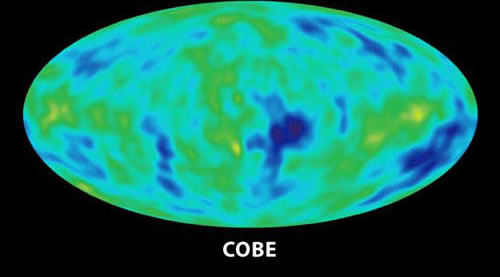 |
| Figure 15.4 Rollover image comparing COBE and WMAP images of the Cosmic Microwave Background |
The mottled patterns in both the COBE and WMAP images are minute temperature variations in the cosmic background. We will return to the WMAP data in section 15.2.
Summary of the History of the Cosmos
Table 15.1 summarizes the "epochs" or stages of the Big Bang:
Time (s) |
Radius of Universe(m) |
Temp (K) |
What's Happening.... |
10-43 |
10-35 |
1032 |
Planck scale - we don't have good enough physics to go beyond this (or maybe string theory?!) |
10-38 |
10-29 |
1029 |
Grand Unification of All Forces, Rapid Inflation |
10-12 |
10-3 |
1016 |
Electroweak Forces Unified |
10-6 |
10-3 |
1013 |
Heavy subatomic particles form |
1 |
108 |
1010 |
Neutrinos |
102 |
1011 |
109 |
Formation of light nuclei (H, He, Li) |
1013 |
1022 |
3 x 103 |
Hydrogen atoms form, end of radiation dominated universe, start of matter dominated universe |
5 x 1017 |
1026 |
3 |
Galaxies and stars and us! |
| Table 15.1 Epochs in the Big Bang | |||
So Why Should YOU Believe the Big Bang Model?
It works! The Big Bang cosmology is a testable scientific model - it makes predictions and provides an explanation for a number of things. You should believe the Big Bang model only to the extent that you believe other scientific models and theories - does it make testable predictions and lead to new insights? You should also remember that this does not exclude the possibility that other models or theories could be constructed that could do just the same or better! As of 2018 there aren't any clearly better physical cosmologies but the recent discoveries of dark energy, the accelerating universe and string theory have spawned a new class of cosmologies.
Let's summarize the success of the Big Bang Cosmology:
|
|
|
|
|
|
Practice
- Why is Olbers' paradox no longer considered a paradox?
- In the early 1930's Hubble's Constant was closer to 500 km/s/Mpc - why was this "problematic'?
- What does Hubble's constant "mean" - explain what units of km/s/Mpc tells us about the Hubble relation
- Show that the units of Hubble's constant are equivalent to units of 1/s.

To understand the basic problems and concerns of cosmology as an experimental science in the 21st century
Chp 18.1,18.2



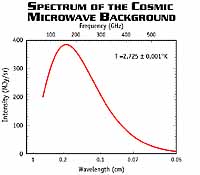
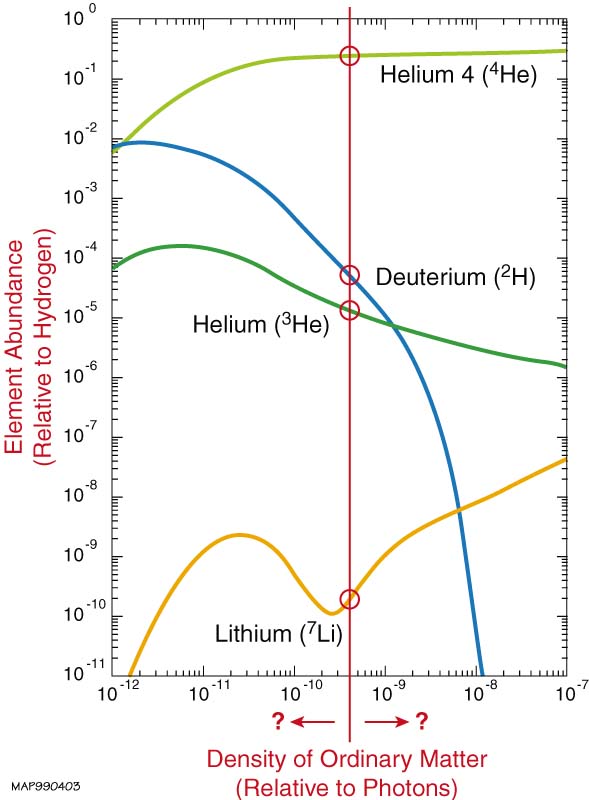
 when H is expressed in km/s/Mpc
when H is expressed in km/s/Mpc